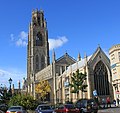Lincolnshire: Difference between revisions
Created page with '{{Infobox county |name=Lincolnshire |map image=LincolnshireBrit5.PNG |flag=FlagOfLincolnshire.PNG |picture= |picture caption= |area=2,646 square miles |county town=Lincoln }}…' |
No edit summary |
||
| (18 intermediate revisions by 3 users not shown) | |||
| Line 1: | Line 1: | ||
{{Infobox county | {{Infobox county | ||
|name=Lincolnshire | |name=Lincolnshire | ||
|map image= | |map image=Lincolnshire Brit Isles Sect 5.svg | ||
|flag= | |flag=Lincolnshire flag.svg | ||
|picture= | |picture=View west from Gunboro Wood - geograph.org.uk - 176388.jpg | ||
|picture caption= | |picture caption=Farmland near Edenham | ||
|county town=[[Lincoln]] | |county town=[[Lincoln]] | ||
}} | }} | ||
[[File:Parts of Lincolnshire.svg|thumb|200px|The Parts of Lincolnshire]] | |||
The '''County of Lincoln''' is a [[Counties of the United Kingdom|shire]] on the east coast of England. It is a low-lying county with much drained fenland, particularly in the south-east. | |||
The county is divided into three parts: | |||
*[[Lindsey]] in the north, itself traditionally divided into three ridings ([[North Riding of Lindsey|North]], [[South Riding of Lindsey|South]] and [[West Riding of Lindsey|West]]); | |||
*[[Kesteven]] in the south-west; and | |||
*[[Holland]] in the south-east. | |||
{{ | Lincolnshire is one of Britain's biggest counties, the fifth largest; but despite having a population of over a million, it has few sizeable towns and remains predominantly agricultural. Its [[county town]] is the city of [[Lincoln]] in the heart of the shire. | ||
Lincolnshire has borders with seven counties, but its longest border is with the sea. The [[East Riding of Yorkshire|East]] and [[West Riding of Yorkshire|West]] Ridings of [[Yorkshire]] stand on Lincolnshire's northern border, [[Nottinghamshire]] and [[Leicestershire]] to the west and [[Rutland]] to the south-west. [[Northamptonshire]] and [[Cambridgeshire]] are to the south and [[Norfolk]] to the south-east. | |||
The broad extent of the county consists of a number of different areas, including the Lincolnshire Fens in the south, the Carrs (similar flat land in the north of the county), the [[Lincolnshire Wolds]], and the industrial towns along the south bank of the [[Humber]] and the [[North Sea]] coast around [[Grimsby]] and [[Scunthorpe]]. | |||
Lincolnshire is a rural area where the pace of life is generally much slower than in much of Britain. Sunday is still largely a day of rest, with only shops in Lincoln, larger market towns, and resorts and industrial towns of the North Sea coast generally remaining open. Some towns and villages in the county still observe half-day closing on Thursdays. Due to the large distances between the towns, many villages have remained very self-contained: most still have shops, pubs, local halls and local chapels and churches, offering a variety of social activities for residents. Fishing (in the extensive river and drainage system in the fens) and shooting are popular activities. | |||
==The Fens== | |||
The Lincolnshire Fens are a part of the Great Fen which spreads over the lands around [[the Wash]] in Lincolnshire and Norfolk and deep inland in Cambridgeshire, Huntingdonshire and the [[Soke of Peterborough]]. Much of the land here is at or below sea level and was once a vast fen of wetland, lakes and channels, now drained the produce fertile farmland. | |||
Inland the fen ends only at the [[Lincoln Edge]], a long, straight running along Lincolnshire a thin, straight line to Lincoln and on to the Humber. | |||
===Drainage=== | |||
The fens need attention to prevent the waters from returning. To this end the lands are drained by various Internal Drainage Boards, such as the Black Sluice Internal Drainage Board, the Lindsey Marsh Drainage Board and the Welland and Deepings Internal Drainage Board.<ref>[http://www.blacksluiceidb.gov.uk/map-of-idbs.html Map of Lincolnshire Drainage Boards]</ref> | |||
==Agriculture== | |||
[[File:Lincsfarmland.jpg|thumb|left|250px|Farmland in Lincolnshire.]] | |||
Lincolnshire is an agricultural area, growing large amounts of wheat, barley, sugar beet, and oilseed rape. In South Lincolnshire, where the soil is particularly rich in nutrients, some of the most common crops include cabbages, cauliflowers, and onions. | |||
Mechanisation around the turn of the 20th century greatly diminished the number of workers required to operate the county's relatively large farms, and the proportion of workers in the agricultural sector dropped substantially during this period. Several major engineering companies developed in Lincoln, Gainsborough and Grantham to support those changes, perhaps most famously Fosters of Lincoln, who built the first tank, and Richard Hornsby & Sons of Grantham. Most such companies are long gone, and Lincolnshire is no longer an engineering centre. | |||
Today, immigrant workers from Central and Eastern Europe supply a very large component of the seasonal agricultural workforce, particularly in the south of the county where more labour-intensive crops such as small vegetables and cut flowers are typically grown. This seasonal influx of migrant labour occasionally causes tension between the migrant workforce and local people, in a county which is still relatively unaccustomed to the large scale immigration experienced by other parts of the United Kingdom. | |||
However, as a result of the current economic climate some food production facilities have closed down, this has caused some reduction in the levels of migrant workers. The large number of Portuguese is still very obvious in the town of Boston, and in Grantham, Poles are found in large numbers.<ref>http://www.granthamjournal.co.uk</ref><ref>{{cite web|author=Published on Tue May 13 09:56:11 BST 2008 |url=http://www.granthamjournal.co.uk/news/UPDATED-Fenland-Foods-workers-to.4075959.jp |title=UPDATED: Fenland Foods workers to protest - Features |publisher=Grantham Journal |date= |accessdate=2010-06-29}}</ref> | |||
==History== | |||
[[File:Lincoln - Castle Square.jpg|thumb|right|250px|The centre of Lincoln]] | |||
The name of Lincoln is ancient. The city was known to the Romans as ''Lindum Colonia'' - Lindum colony - and from this comes "Lincoln", the name by which the city has been known since Anglo-Saxon times. A major Roman road was driven through Lincolnshire, Ermine Street, running to ''Lindum''. Northern Lincolnshire became in the early Saxon period the Kingdom of Lindsey, which passed between Mercian and Northumbrian control over the unsettled period before Mercian supremacy was established. The name of [[Lindsey]] remains. | |||
The Danes broke upon the land in the ninth century, armies followed by settlers, and many of the Lincolnshire place-names reflect their Scandinavian heritage; towns and villages with names ending ''-by'' and ''-thorpe'' are particularly concentrated in this county. The Danes established a fortified presence with armies based at [[Lincoln]] and at [[Stamford]]. It is assumed that Lincolnshire as a shire was created at the reconquest in the ninth century from the joining of these two Danish army-lands. | |||
The Normans moved the seat of the Midlands bishopric from [[Dorchester on Thames]] to Lincoln, and built the vast Lincoln Cathedral. They also built Lincoln Castle which still stands proud over the city. The Middle Ages were a time in which Lincoln became one of the most important cities of the kingdom. Boston in Holland throve as a port, and indeed it was the major port for the Baltic Trade into the nineteenth century when its port began to prove ill-suited to the great ships of the age. | |||
The industrial revolution had its main impact on the Humber, which great ships could enter. | |||
<gallery> | |||
File: Belton House 2006 Giano.jpg|[[Belton House]] | |||
File: Stump&Ingram.jpeg|St Botolph's Church (The Boston Stump) | |||
File: Gainsborough Old Hall.jpg|Gainsborough Old Hall | |||
File: Harlaxton manor.jpg|Harlaxton Manor | |||
File: 056340 6922c33e-by-David-Wright.jpg|Normanby Hall | |||
File: Tattershall Castle, 2006.jpg|Tattershall Castle | |||
File: Thornton Abbey Gatehouse1.jpg|Thornton Abbey | |||
</gallery> | |||
== Towns and villages == | |||
[[File:Lincoln Cathedral.jpg|thumb|right|250px|The Norman West Front of Lincoln Cathedral]] | |||
The main towns of Lincolnshire are the City of Lincoln, Scunthorpe, Great Grimsby and Boston. | |||
Cities: | |||
*[[Lincoln]] | |||
Towns: | |||
{{div col|3}} | |||
*[[Boston]] | |||
*[[Bourne, Lincolnshire|Bourne]] | |||
*[[Gainsborough]] | |||
*[[Grantham]] | |||
*[[Great Grimsby]] | |||
*[[Louth, Lincolnshire|Louth]] | |||
*[[Mablethorpe]] | |||
*[[Scunthorpe]] | |||
*[[Skegness]] | |||
*[[Sleaford]] | |||
*[[Spalding]] | |||
*[[Stamford]] | |||
{{div col end}} | |||
Smaller towns and larger villages: | |||
{{div col|3}} | |||
*[[Alford, Lincolnshire|Alford]] | |||
*[[Barton-upon-Humber]] | |||
*[[Brigg]] | |||
*[[Caistor]] | |||
*[[Cleethorpes]] | |||
*[[Coningsby]] | |||
*[[Crowland]] | |||
*[[Deeping St James]] | |||
*[[Heckington]] | |||
*[[Holbeach]] | |||
*[[Horncastle, Lincolnshire|Horncastle]] | |||
*[[Humberston]] | |||
*[[Immingham]] | |||
*[[Market Deeping]] | |||
*[[Market Rasen]] | |||
*[[Long Sutton, Lincolnshire|Long Sutton]] | |||
*[[Sutton Bridge]] | |||
*[[Waltham, Lincolnshire|Waltham]] | |||
*[[Woodhall Spa]] | |||
{{div col end}} | |||
Many of the towns in the county continue to hold a weekly market, a centuries-old tradition reinvigorated recently by the growth of farmers' markets. | |||
==Wapentakes== | |||
[[File:Lincolnshire Wapentakes.svg|thumb|250px|The wapentakes of Lincolnshire]] | |||
The county is divided into 30 wapentakes: | |||
{{div col|3}} | |||
*[[Aslacoe Wapentake]] | |||
*[[Aswardhurn|Aswardhurn Wapentake]] | |||
*[[Aveland|Aveland Wapentake]] | |||
*[[Beltisloe|Beltisloe Wapentake]] | |||
*[[Bolingbroke Soke]] | |||
*[[Boothby Graffoe Wapentake]] | |||
*[[Bradley Haverstoe Wapentake]] | |||
*[[Calceworth Hundred]] | |||
*[[Candleshoe Wapentake]] | |||
*[[Corringham Wapentake]] | |||
*[[Elloe Wapentake]] | |||
*[[Flaxwell|Flaxwell Wapentake]] | |||
*[[Gartree Wapentake]] | |||
*[[Grantham Soke]] | |||
*[[Hill Hundred]] | |||
*[[Horncastle Soke]] | |||
*[[Kirton Wapentake]] | |||
*[[Langoe|Langoe Wapentake]] | |||
*[[Lawress Wapentake]] | |||
*[[Louth-Eske Hundred]] | |||
*[[Loveden|Loveden Wapentake]] | |||
*[[Ludborough Wapentake]] | |||
*[[Manley Wapentake]] | |||
*[[Ness Wapentake]] | |||
*[[Skirbeck Wapentake]] | |||
*[[Walshcroft Wapentake]] | |||
*[[Well Wapentake]] | |||
*[[Winnibriggs and Threo|Winnibriggs and Threo Wapentake]] | |||
*[[Wraggoe Wapentake]] | |||
*[[Yarborough Wapentake]] | |||
{{div col end}} | |||
===People=== | |||
Lincolnshire is relatively unusual in the composition of its population, being one of the least ethnically diverse counties of the United Kingdom (98.5% of the population describe themselves as "white"). Over recent years inward migration by people from ethnic minority communities has increased (particularly to population centres such as Lincoln and Boston) but the absolute number of non-white Lincolnshire residents remains very low. | |||
Recently, the county has also witnessed a growing trend towards immigration of retired people from other parts of the United Kingdom, particularly those from the southern counties attracted by the generally lower property prices and the slower and more relaxed pace of life. The relatively high proportion of elderly and retired people is reflected in many of the services, activities and events. [[Sleaford]] is considered one of the fastest growing towns in the eastern Midlands, with many professional people moving there to benefit from (relatively) low house prices, average crime rate and the selective education offered. | |||
Those born in Lincolnshire are sometimes given the nickname of Yellowbellies. The origin of this term is debated, but is most commonly believed to derive from the uniforms of the 10th Regiment of Foot (later the Lincolnshire Regiment) who wore a very bright yellow waistcoat for identification on the battlefield. | |||
==Culture== | |||
Lincolnshire has its own distinctive accents, little known outside the shire, though inevitably being lost from the towns though the rubbings of modernity. | |||
Lincolnshire was historically associated with the Lincolnshire bagpipe, an instrument derided as a coarse and unpleasant instrument in contemporary literature, but noted as very popular in the county. The last player, John Hunsley of South Somercotes, died around 1850, and since then the instrument has been extinct. | |||
In 1967, Percy Grainger wrote his Lincolnshire Posy for wind band. The piece is a compilation of folksongs "musical wildflowers" collected by the composer in and around the county of Lincoln. | |||
===Food=== | |||
Lincolnshire has a number of local dishes: | |||
*Stuffed chine – this is salted neck-chine of a pig taken from between the shoulder blades, salted for up to ten months and stuffed with parsley stuffing (other ingredients are normally kept secret), and served cold. It is considered by many in the county to be an acquired taste. | |||
*haslet – a type of pork loaf, also flavoured with sage (pronounced HAYSS-let in Lincolnshire but HAZ-let in many other parts of the country). | |||
*Lincolnshire sausage - most butchers in Lincolnshire have their own secret recipe for these and a competition is held each year to judge the best sausages in the county. Traditional Lincolnshire sausages are made entirely from minced pork, stale bread crumb (rusk is used nowadays) pepper, sage and salt. The skins should be natural casings which are made from the intestines of either sheep or pig. | |||
*Pork pies – the same pork butchers will take a pride in their unique recipe for pork pies. | |||
*Plum bread – as with plum pudding, plum refers to dried fruit, namely currants, raisins and sultanas, sometimes soaked in tea. | |||
*Grantham Gingerbread – a hard white ginger biscuit. | |||
*Lincolnshire Poacher Cheese – cheddar cheese produced in Alford. Lincolnshire Poacher has won numerous awards over the years including Supreme Champion at the 1996/7 British Cheese Awards and Best British Cheese at the World Cheese awards in 2001/2. There have also been several Gold Medals at the British Cheese Awards, including 2003/4 for both Lincolnshire Poacher and Smoked Lincolnshire Poacher. In October 2006, Lincolnshire Poacher was awarded Best Export Cheese at the British Cheese Awards, and most recently at the 2009/10 awards were awarded Best Modern British Cheese (for Lincolnshire Poacher) and Best Flavour Added Cheese (for Smoked Poacher). | |||
*Grimsby is renowned for its fishing industry, and historically ''Grimsby Fish'' has carried a premium price. Since the decline of the fishing industry since the 1970s this is no longer the case and the majority of fish sold at the town's fish market being brought overland from other ports. However ''Grimsby Fish'' is still a recognised local product as granted "Protected Geographical Indication", reflecting the unique smoking methods used by certain local fish companies.<ref>{{cite news| url=http://www.timesonline.co.uk/tol/life_and_style/food_and_drink/article6919386.ece | location=London | work=The Times | title=Traditional Grimsby Smoked Fish is granted European PGI status | first=Valerie | last=Elliott | date=2009-11-17}}</ref> | |||
===Events=== | |||
Every year the Lincolnshire Agricultural Society, founded in 1869, stages the Lincolnshire Agricultural Show.<ref>{{cite web|url=http://www.lincolnshireshowground.co.uk |title=Lincolnshire Events Centre |publisher=Lincolnshire Showground |date= |accessdate=2010-06-29}}</ref> It is held on the Wednesday and Thursday of the last whole week of June at its Showground at Grange de Lings, a few miles north of [[Lincoln]] on the A15. The show was first held here in 1958. First held around the year 1884, it is one of the largest agricultural shows in the country, and is attended by around 100,000 people over its two days. The Showground is in regular use throughout the year for a wide range of other events and functions. | |||
Smaller local agricultural shows, such as the Deeping Show or the Heckington Show<ref>{{cite web|url=http://www.heckingtonshow.org.uk/ |title=The Largest Village Show In England |publisher=Heckingtonshow.org.uk |date= |accessdate=2010-06-29}}</ref> can still be found. [[Corby Glen]] sheep fair<ref>{{cite web|url=http://www.corbyglen.com/sheepfair/gallery.html |title=Corby Glen Sheep Fair Gallery |publisher=Corbyglen.com |date= |accessdate=2010-06-29}}</ref> has been held every year since 1238. | |||
Each year RAF Waddington is the home to the RAF Waddington Air Show. The two day event attracts around 40,000 people and usually takes place during the last weekend of June. | |||
On the Monday before Easter, an unusual auction takes place in [[Bourne, Lincolnshire|Bourne]] to let the grazing rights of the Whitebread Meadow.<ref>{{cite web|url=http://homepages.which.net/~rex/bourne/wbmeadow.htm |title=The White Bread Meadow |publisher=Homepages.which.net |date= |accessdate=2010-06-29}}</ref> Bidding takes place while two boys race toward the Queen's Bridge in Eastgate, the end of which dash is equivalent to the falling of the gavel. The whole affair dates back to the 1742 will of William Clay. | |||
The [[Haxey#Haxey Hood|Haxey Hood]] village competition takes place every January, as it has for over 700 years. | |||
[[Stamford]] Mid-Lent fair sees showmen converge on the town the week after Mothering Sunday, with rides and sideshows filling Broad Street, the Sheepmarket and the Meadows for a week. Stalls selling Grantham gingerbread and nougat are a traditional feature. The following week sees them in [[Grantham]], on the way North for the Summer. [http://www.rogertuby.co.uk/ Roger Tuby] brings a small funfair to Bourne and then to Spalding in Spring and returns in Autumn at the end of the season. | |||
The villages of [[Tetford]] and [[Salmonby]] hold an annual Scarecrow Festival in May every year. | |||
The [[Belchford]] Downhill Challenge which is held every two years: soapbox racers race down the hill at up to 20 mph. The turnout has been up to 1,000. | |||
In recent years Lincoln Christmas Market, a street market throughout historic area of the city, has been held at the start of December. Around the same time Christmas lights are turned on in [[Bourne, Lincolnshire|Bourne]], [[Sleaford]], [[Skegness]], and other towns. | |||
Throughout the summer the Stamford Shakespeare Company<ref>{{cite web|url=http://www.stamfordshakespeare.co.uk/ |title=Stamford Shakespeare Company |publisher=Stamfordshakespeare.co.uk |date= |accessdate=2010-06-29}}</ref> presents the Bard's plays in the open air theatre at Tolethorpe Hall, which is actually just across the border in [[Rutland]]. | |||
The [[Spalding]] Flower Parade is held in late spring every year. Colourful floats decorated with tulip heads compete for a cup. The tradition was started in 1959, and draws coach tours from across Britain. There was talk of 2008 being the last parade, but a smaller event planned for 2009<ref>{{cite web|url=http://www.spaldingtoday.co.uk/news/Not-the-end-of-Spalding.4433345.jp |title=Not the end of Spalding Flower Parade |publisher=Spalding Today |date= |accessdate=2010-06-29}}</ref> may set the pattern for future years. | |||
===Symbols=== | |||
[[File:FlagOfLincolnshire.PNG|thumb|250px|right|The Lincolnshire flag]] | |||
The unofficial anthem of the county is the traditional folk song, "The Lincolnshire Poacher", which dates from around 1776. A version of the song was the theme to BBC Radio Lincolnshire for many years. | |||
Plantlife named as the [[county flower]] of Lincolnshire the Common Dog-violet. | |||
The Lincolnshire flag originated in a competition launches In August 2005, BBC Radio Lincolnshire and ''Lincolnshire Life'' magazine launched a vote for a flag to represent the county. Six competing designs were voted upon by locals. The winning submission was unveiled in October 2005,<ref> | |||
{{cite news | |||
|title=New county flag design unveiled | |||
|url=http://news.bbc.co.uk/2/hi/uk_news/england/lincolnshire/4371070.stm | |||
|publisher=BBC News | |||
|date=24 October 2005 | |||
|accessdate=2010-02-15}} | |||
</ref><ref>[{{Flag Institute|Lincolnshire}} Lincolnshire flag on the UK Flag Register]</ref> which combines the arms of Lincoln (a red cross bearing a fleur-de-lys) with a yellow border for the "Lincolnshire Yellowbellies" and green and blue for the fields and floods of the county. | |||
The Lincoln Imp has symbolised Cathedral, City, and county for many years. | |||
==Things to see in Lincolnshire== | |||
[[File:"Boston Stump" - geograph.org.uk - 3978.jpg|right|thumb|220px|The Boston Stump]] | |||
[[File:Mount Pleasant Mill, Kirton in Lindsey.jpg|right|thumb|220px|Mount Pleasant Mill]] | |||
{{UKPlacesKey|E}} | |||
*{{i-House}} [[Alford Manor House]] | |||
*Alford Windmill | |||
*Alkborough Turf Maze | |||
*{{i-House}}{{i-Museum}} [[Ayscoughfee Hall]] | |||
*{{i-Museum}} Baldocks Mill | |||
*Belmont Mast | |||
*{{i-House}}{{i-NTE}} [[Belton House]] | |||
*{{i-Castle}}{{i-EH}} [[Bolingbroke Castle]] | |||
*{{i-Church}} Boston Stump | |||
*{{i-Abbey}} Bourne Abbey | |||
*{{i-OpenSpace}} Boultham Park | |||
*{{i-House}} [[Branston Hall]] | |||
*{{i-Museum}} Church Farm Museum, [[Skegness]] | |||
*{{i-Abbey}} [[Crowland Abbey]] | |||
*{{i-Museum}} Cogglesford Mill | |||
*{{i-Museum}} Dambusters Inn and Heritage Centre | |||
*{{i-House}} [[Doddington Hall]] | |||
*{{i-Museum}} Dogdyke Engine | |||
*Donna Nook | |||
*Dunston Pillar | |||
*East Lighthouse, Sutton Bridge | |||
*Ellis Mill (Windmill) | |||
*{{i-Themepark}} Fantasy Island UK | |||
*{{i-House}}{{i-EH}} [[Gainsborough Old Hall]] | |||
*{{i-EH}} [[Gainsthorpe]] Deserted Mediæval Village | |||
*[[Gibraltar Point]] | |||
*{{i-MuseumNotFree}} Gordon Boswell Romany Museum | |||
*{{i-Museum}} [[Grantham]] Museum | |||
*[[Grimsby]] Dock Tower | |||
*{{i-Castle}} [[Grimsthorpe Castle]] | |||
*{{i-House}}{{i-NTE}} [[Gunby Hall]] | |||
*{{i-Park}} Hartsholme Country Park | |||
*{{i-House}} [[Harlaxton Manor]] | |||
*[[Heckington]] Windmill | |||
*{{i-Forest}} Kesteven Forest | |||
*{{i-Castle}} [[Lincoln Castle]] | |||
*{{i-Cathedral}} [[Lincoln Cathedral]] | |||
*{{i-Museum}} Lincolnshire Aviation Heritage Centre | |||
*{{i-HR}} [[Lincolnshire Wolds Railway]] | |||
*Maud Foster Windmill, Skirbeck, [[Boston]] | |||
*[[Metheringham]] Windmill | |||
*Mount Pleasant Mill, [[Kirton in Lindsey]] | |||
*{{i-MuseumNotFree}} Mrs Smith's Cottage, [[Navenby]] | |||
*{{i-MuseumNotFree}} National Fishing Heritage Centre | |||
*Natureland Seal Sanctuary | |||
*{{i-House}} [[Normanby Hall]] | |||
*[[Pelham's Pillar]] | |||
*{{i-Museum}} Pinchbeck Engine and Museum of Land Drainage | |||
*{{i-Themepark}} Pleasure Island, [[Cleethorpes]] | |||
*[[River Ancholme]] | |||
*{{i-Park}} Snipe Dales | |||
*{{i-Church}} St James Church, [[Louth, Lincolnshire|Louth]] | |||
*{{i-Church}}{{i-EH}} St Peter's Church, [[Barton upon Humber]] | |||
*[[Sibsey]] Trader Mill | |||
*[[Stamford]] Meadows | |||
*{{i-Museum}} [[Stamford]] Museum | |||
*{{i-Abbey}} [[Stow Minster]] | |||
*{{i-Castle}}{{i-NTE}} [[Tattershall Castle]] | |||
*{{i-EH}} [[Tattershall College]] | |||
*The Collection (The Usher Art Gallery) | |||
*The [[Humber Bridge]] | |||
*{{i-OpenSpace}} The [[Lincolnshire Wolds]] | |||
*{{i-MuseumNotFree}} The Museum of Lincolnshire Life | |||
*{{i-OpenSpace}} The South Common, [[Lincoln]] | |||
*[[The Wash]] | |||
*{{i-OpenSpace}} The West Common, [[Lincoln]] | |||
*{{i-Abbey}}{{i-EH}} [[Thornton Abbey]] | |||
*[[Waltham Windmill]] | |||
*Whisby Nature Park | |||
*{{i-House}}{{i-NTE}} [[Woolsthorpe Manor]] | |||
== References == | |||
{{reflist|2}} | |||
*{{cite book|editor1-first=C. W. |editor1-last=Foster |editor2-first=Thomas |editor2-last=Longley|title=The Lincolnshire Domesday and Lindsey Survey|publisher=Lincoln Record Society|location=Horncastle|series=Annual works of the society |year=1924|volume=19}} | |||
==Outside links== | |||
{{commons category|Lincolnshire}} | |||
*[http://www.visitlincolnshire.com/ Visitlincolnshire.com] | |||
*[http://www.lincolnshireshow.info/ Lincolnshire Show official website] | |||
*[http://www.britishpathe.com/record.php?id=29326 Pathe newsreel of motor tractors at 1919 agricultural show, thought to be the Lincoln Show] | |||
{{British county}} | {{British county}} | ||
Latest revision as of 18:10, 16 May 2020
| Lincolnshire United Kingdom | |
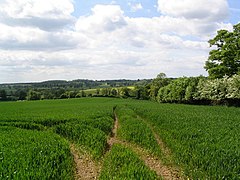 Farmland near Edenham | |
|---|---|

| |
| Flag | |
| Perseverance vincit (Perseverance conquers) | |
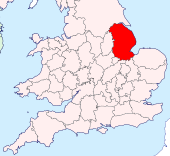
| |
| [Interactive map] | |
| Area: | 2,687 square miles |
| Population: | 1,038,510 |
| County town: | Lincoln |
| County flower: | Common dog-violet [1] |
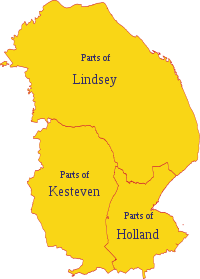
The County of Lincoln is a shire on the east coast of England. It is a low-lying county with much drained fenland, particularly in the south-east.
The county is divided into three parts:
- Lindsey in the north, itself traditionally divided into three ridings (North, South and West);
- Kesteven in the south-west; and
- Holland in the south-east.
Lincolnshire is one of Britain's biggest counties, the fifth largest; but despite having a population of over a million, it has few sizeable towns and remains predominantly agricultural. Its county town is the city of Lincoln in the heart of the shire.
Lincolnshire has borders with seven counties, but its longest border is with the sea. The East and West Ridings of Yorkshire stand on Lincolnshire's northern border, Nottinghamshire and Leicestershire to the west and Rutland to the south-west. Northamptonshire and Cambridgeshire are to the south and Norfolk to the south-east.
The broad extent of the county consists of a number of different areas, including the Lincolnshire Fens in the south, the Carrs (similar flat land in the north of the county), the Lincolnshire Wolds, and the industrial towns along the south bank of the Humber and the North Sea coast around Grimsby and Scunthorpe.
Lincolnshire is a rural area where the pace of life is generally much slower than in much of Britain. Sunday is still largely a day of rest, with only shops in Lincoln, larger market towns, and resorts and industrial towns of the North Sea coast generally remaining open. Some towns and villages in the county still observe half-day closing on Thursdays. Due to the large distances between the towns, many villages have remained very self-contained: most still have shops, pubs, local halls and local chapels and churches, offering a variety of social activities for residents. Fishing (in the extensive river and drainage system in the fens) and shooting are popular activities.
The Fens
The Lincolnshire Fens are a part of the Great Fen which spreads over the lands around the Wash in Lincolnshire and Norfolk and deep inland in Cambridgeshire, Huntingdonshire and the Soke of Peterborough. Much of the land here is at or below sea level and was once a vast fen of wetland, lakes and channels, now drained the produce fertile farmland.
Inland the fen ends only at the Lincoln Edge, a long, straight running along Lincolnshire a thin, straight line to Lincoln and on to the Humber.
Drainage
The fens need attention to prevent the waters from returning. To this end the lands are drained by various Internal Drainage Boards, such as the Black Sluice Internal Drainage Board, the Lindsey Marsh Drainage Board and the Welland and Deepings Internal Drainage Board.[1]
Agriculture

Lincolnshire is an agricultural area, growing large amounts of wheat, barley, sugar beet, and oilseed rape. In South Lincolnshire, where the soil is particularly rich in nutrients, some of the most common crops include cabbages, cauliflowers, and onions.
Mechanisation around the turn of the 20th century greatly diminished the number of workers required to operate the county's relatively large farms, and the proportion of workers in the agricultural sector dropped substantially during this period. Several major engineering companies developed in Lincoln, Gainsborough and Grantham to support those changes, perhaps most famously Fosters of Lincoln, who built the first tank, and Richard Hornsby & Sons of Grantham. Most such companies are long gone, and Lincolnshire is no longer an engineering centre.
Today, immigrant workers from Central and Eastern Europe supply a very large component of the seasonal agricultural workforce, particularly in the south of the county where more labour-intensive crops such as small vegetables and cut flowers are typically grown. This seasonal influx of migrant labour occasionally causes tension between the migrant workforce and local people, in a county which is still relatively unaccustomed to the large scale immigration experienced by other parts of the United Kingdom.
However, as a result of the current economic climate some food production facilities have closed down, this has caused some reduction in the levels of migrant workers. The large number of Portuguese is still very obvious in the town of Boston, and in Grantham, Poles are found in large numbers.[2][3]
History
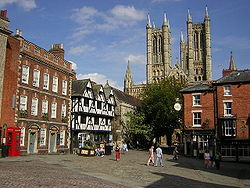
The name of Lincoln is ancient. The city was known to the Romans as Lindum Colonia - Lindum colony - and from this comes "Lincoln", the name by which the city has been known since Anglo-Saxon times. A major Roman road was driven through Lincolnshire, Ermine Street, running to Lindum. Northern Lincolnshire became in the early Saxon period the Kingdom of Lindsey, which passed between Mercian and Northumbrian control over the unsettled period before Mercian supremacy was established. The name of Lindsey remains.
The Danes broke upon the land in the ninth century, armies followed by settlers, and many of the Lincolnshire place-names reflect their Scandinavian heritage; towns and villages with names ending -by and -thorpe are particularly concentrated in this county. The Danes established a fortified presence with armies based at Lincoln and at Stamford. It is assumed that Lincolnshire as a shire was created at the reconquest in the ninth century from the joining of these two Danish army-lands.
The Normans moved the seat of the Midlands bishopric from Dorchester on Thames to Lincoln, and built the vast Lincoln Cathedral. They also built Lincoln Castle which still stands proud over the city. The Middle Ages were a time in which Lincoln became one of the most important cities of the kingdom. Boston in Holland throve as a port, and indeed it was the major port for the Baltic Trade into the nineteenth century when its port began to prove ill-suited to the great ships of the age.
The industrial revolution had its main impact on the Humber, which great ships could enter.
-
St Botolph's Church (The Boston Stump)
-
Gainsborough Old Hall
-
Harlaxton Manor
-
Normanby Hall
-
Tattershall Castle
-
Thornton Abbey
Towns and villages
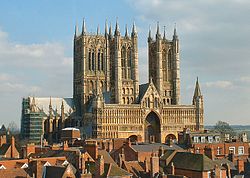
The main towns of Lincolnshire are the City of Lincoln, Scunthorpe, Great Grimsby and Boston.
Cities:
Towns:
Smaller towns and larger villages:
Many of the towns in the county continue to hold a weekly market, a centuries-old tradition reinvigorated recently by the growth of farmers' markets.
Wapentakes
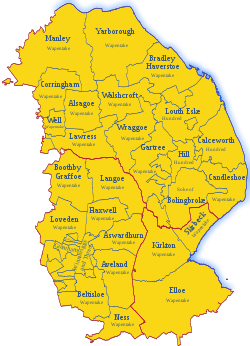
The county is divided into 30 wapentakes:
- Aslacoe Wapentake
- Aswardhurn Wapentake
- Aveland Wapentake
- Beltisloe Wapentake
- Bolingbroke Soke
- Boothby Graffoe Wapentake
- Bradley Haverstoe Wapentake
- Calceworth Hundred
- Candleshoe Wapentake
- Corringham Wapentake
- Elloe Wapentake
- Flaxwell Wapentake
- Gartree Wapentake
- Grantham Soke
- Hill Hundred
- Horncastle Soke
- Kirton Wapentake
- Langoe Wapentake
- Lawress Wapentake
- Louth-Eske Hundred
- Loveden Wapentake
- Ludborough Wapentake
- Manley Wapentake
- Ness Wapentake
- Skirbeck Wapentake
- Walshcroft Wapentake
- Well Wapentake
- Winnibriggs and Threo Wapentake
- Wraggoe Wapentake
- Yarborough Wapentake
People
Lincolnshire is relatively unusual in the composition of its population, being one of the least ethnically diverse counties of the United Kingdom (98.5% of the population describe themselves as "white"). Over recent years inward migration by people from ethnic minority communities has increased (particularly to population centres such as Lincoln and Boston) but the absolute number of non-white Lincolnshire residents remains very low.
Recently, the county has also witnessed a growing trend towards immigration of retired people from other parts of the United Kingdom, particularly those from the southern counties attracted by the generally lower property prices and the slower and more relaxed pace of life. The relatively high proportion of elderly and retired people is reflected in many of the services, activities and events. Sleaford is considered one of the fastest growing towns in the eastern Midlands, with many professional people moving there to benefit from (relatively) low house prices, average crime rate and the selective education offered.
Those born in Lincolnshire are sometimes given the nickname of Yellowbellies. The origin of this term is debated, but is most commonly believed to derive from the uniforms of the 10th Regiment of Foot (later the Lincolnshire Regiment) who wore a very bright yellow waistcoat for identification on the battlefield.
Culture
Lincolnshire has its own distinctive accents, little known outside the shire, though inevitably being lost from the towns though the rubbings of modernity.
Lincolnshire was historically associated with the Lincolnshire bagpipe, an instrument derided as a coarse and unpleasant instrument in contemporary literature, but noted as very popular in the county. The last player, John Hunsley of South Somercotes, died around 1850, and since then the instrument has been extinct.
In 1967, Percy Grainger wrote his Lincolnshire Posy for wind band. The piece is a compilation of folksongs "musical wildflowers" collected by the composer in and around the county of Lincoln.
Food
Lincolnshire has a number of local dishes:
- Stuffed chine – this is salted neck-chine of a pig taken from between the shoulder blades, salted for up to ten months and stuffed with parsley stuffing (other ingredients are normally kept secret), and served cold. It is considered by many in the county to be an acquired taste.
- haslet – a type of pork loaf, also flavoured with sage (pronounced HAYSS-let in Lincolnshire but HAZ-let in many other parts of the country).
- Lincolnshire sausage - most butchers in Lincolnshire have their own secret recipe for these and a competition is held each year to judge the best sausages in the county. Traditional Lincolnshire sausages are made entirely from minced pork, stale bread crumb (rusk is used nowadays) pepper, sage and salt. The skins should be natural casings which are made from the intestines of either sheep or pig.
- Pork pies – the same pork butchers will take a pride in their unique recipe for pork pies.
- Plum bread – as with plum pudding, plum refers to dried fruit, namely currants, raisins and sultanas, sometimes soaked in tea.
- Grantham Gingerbread – a hard white ginger biscuit.
- Lincolnshire Poacher Cheese – cheddar cheese produced in Alford. Lincolnshire Poacher has won numerous awards over the years including Supreme Champion at the 1996/7 British Cheese Awards and Best British Cheese at the World Cheese awards in 2001/2. There have also been several Gold Medals at the British Cheese Awards, including 2003/4 for both Lincolnshire Poacher and Smoked Lincolnshire Poacher. In October 2006, Lincolnshire Poacher was awarded Best Export Cheese at the British Cheese Awards, and most recently at the 2009/10 awards were awarded Best Modern British Cheese (for Lincolnshire Poacher) and Best Flavour Added Cheese (for Smoked Poacher).
- Grimsby is renowned for its fishing industry, and historically Grimsby Fish has carried a premium price. Since the decline of the fishing industry since the 1970s this is no longer the case and the majority of fish sold at the town's fish market being brought overland from other ports. However Grimsby Fish is still a recognised local product as granted "Protected Geographical Indication", reflecting the unique smoking methods used by certain local fish companies.[4]
Events
Every year the Lincolnshire Agricultural Society, founded in 1869, stages the Lincolnshire Agricultural Show.[5] It is held on the Wednesday and Thursday of the last whole week of June at its Showground at Grange de Lings, a few miles north of Lincoln on the A15. The show was first held here in 1958. First held around the year 1884, it is one of the largest agricultural shows in the country, and is attended by around 100,000 people over its two days. The Showground is in regular use throughout the year for a wide range of other events and functions.
Smaller local agricultural shows, such as the Deeping Show or the Heckington Show[6] can still be found. Corby Glen sheep fair[7] has been held every year since 1238.
Each year RAF Waddington is the home to the RAF Waddington Air Show. The two day event attracts around 40,000 people and usually takes place during the last weekend of June.
On the Monday before Easter, an unusual auction takes place in Bourne to let the grazing rights of the Whitebread Meadow.[8] Bidding takes place while two boys race toward the Queen's Bridge in Eastgate, the end of which dash is equivalent to the falling of the gavel. The whole affair dates back to the 1742 will of William Clay.
The Haxey Hood village competition takes place every January, as it has for over 700 years.
Stamford Mid-Lent fair sees showmen converge on the town the week after Mothering Sunday, with rides and sideshows filling Broad Street, the Sheepmarket and the Meadows for a week. Stalls selling Grantham gingerbread and nougat are a traditional feature. The following week sees them in Grantham, on the way North for the Summer. Roger Tuby brings a small funfair to Bourne and then to Spalding in Spring and returns in Autumn at the end of the season.
The villages of Tetford and Salmonby hold an annual Scarecrow Festival in May every year.
The Belchford Downhill Challenge which is held every two years: soapbox racers race down the hill at up to 20 mph. The turnout has been up to 1,000.
In recent years Lincoln Christmas Market, a street market throughout historic area of the city, has been held at the start of December. Around the same time Christmas lights are turned on in Bourne, Sleaford, Skegness, and other towns.
Throughout the summer the Stamford Shakespeare Company[9] presents the Bard's plays in the open air theatre at Tolethorpe Hall, which is actually just across the border in Rutland.
The Spalding Flower Parade is held in late spring every year. Colourful floats decorated with tulip heads compete for a cup. The tradition was started in 1959, and draws coach tours from across Britain. There was talk of 2008 being the last parade, but a smaller event planned for 2009[10] may set the pattern for future years.
Symbols
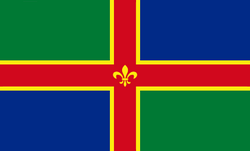
The unofficial anthem of the county is the traditional folk song, "The Lincolnshire Poacher", which dates from around 1776. A version of the song was the theme to BBC Radio Lincolnshire for many years.
Plantlife named as the county flower of Lincolnshire the Common Dog-violet.
The Lincolnshire flag originated in a competition launches In August 2005, BBC Radio Lincolnshire and Lincolnshire Life magazine launched a vote for a flag to represent the county. Six competing designs were voted upon by locals. The winning submission was unveiled in October 2005,[11][12] which combines the arms of Lincoln (a red cross bearing a fleur-de-lys) with a yellow border for the "Lincolnshire Yellowbellies" and green and blue for the fields and floods of the county.
The Lincoln Imp has symbolised Cathedral, City, and county for many years.
Things to see in Lincolnshire
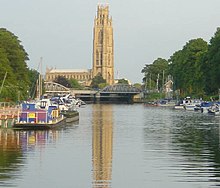
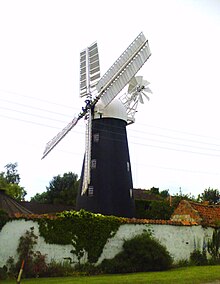
| Key | |
| Cathedral/Abbey/Priory | |
| Accessible open space | |
| Amusement/Theme Park | |
| Castle | |
| Country Park | |
| English Heritage | |
| Forestry Commission | |
| Heritage railway | |
| Historic House | |
| Museum (free/not free) | |
| National Trust | |
| Zoo | |
 Alford Manor House
Alford Manor House- Alford Windmill
- Alkborough Turf Maze

 Ayscoughfee Hall
Ayscoughfee Hall Baldocks Mill
Baldocks Mill- Belmont Mast

 Belton House
Belton House
 Bolingbroke Castle
Bolingbroke Castle Boston Stump
Boston Stump Bourne Abbey
Bourne Abbey Boultham Park
Boultham Park Branston Hall
Branston Hall Church Farm Museum, Skegness
Church Farm Museum, Skegness Crowland Abbey
Crowland Abbey Cogglesford Mill
Cogglesford Mill Dambusters Inn and Heritage Centre
Dambusters Inn and Heritage Centre Doddington Hall
Doddington Hall Dogdyke Engine
Dogdyke Engine- Donna Nook
- Dunston Pillar
- East Lighthouse, Sutton Bridge
- Ellis Mill (Windmill)
 Fantasy Island UK
Fantasy Island UK
 Gainsborough Old Hall
Gainsborough Old Hall Gainsthorpe Deserted Mediæval Village
Gainsthorpe Deserted Mediæval Village- Gibraltar Point
 Gordon Boswell Romany Museum
Gordon Boswell Romany Museum Grantham Museum
Grantham Museum- Grimsby Dock Tower
 Grimsthorpe Castle
Grimsthorpe Castle
 Gunby Hall
Gunby Hall Hartsholme Country Park
Hartsholme Country Park Harlaxton Manor
Harlaxton Manor- Heckington Windmill
 Kesteven Forest
Kesteven Forest Lincoln Castle
Lincoln Castle Lincoln Cathedral
Lincoln Cathedral Lincolnshire Aviation Heritage Centre
Lincolnshire Aviation Heritage Centre Lincolnshire Wolds Railway
Lincolnshire Wolds Railway- Maud Foster Windmill, Skirbeck, Boston
- Metheringham Windmill
- Mount Pleasant Mill, Kirton in Lindsey
 Mrs Smith's Cottage, Navenby
Mrs Smith's Cottage, Navenby National Fishing Heritage Centre
National Fishing Heritage Centre- Natureland Seal Sanctuary
 Normanby Hall
Normanby Hall- Pelham's Pillar
 Pinchbeck Engine and Museum of Land Drainage
Pinchbeck Engine and Museum of Land Drainage Pleasure Island, Cleethorpes
Pleasure Island, Cleethorpes- River Ancholme
 Snipe Dales
Snipe Dales St James Church, Louth
St James Church, Louth
 St Peter's Church, Barton upon Humber
St Peter's Church, Barton upon Humber- Sibsey Trader Mill
- Stamford Meadows
 Stamford Museum
Stamford Museum Stow Minster
Stow Minster
 Tattershall Castle
Tattershall Castle Tattershall College
Tattershall College- The Collection (The Usher Art Gallery)
- The Humber Bridge
 The Lincolnshire Wolds
The Lincolnshire Wolds The Museum of Lincolnshire Life
The Museum of Lincolnshire Life The South Common, Lincoln
The South Common, Lincoln- The Wash
 The West Common, Lincoln
The West Common, Lincoln
 Thornton Abbey
Thornton Abbey- Waltham Windmill
- Whisby Nature Park

 Woolsthorpe Manor
Woolsthorpe Manor
References
- ↑ Map of Lincolnshire Drainage Boards
- ↑ http://www.granthamjournal.co.uk
- ↑ Published on Tue May 13 09:56:11 BST 2008. "UPDATED: Fenland Foods workers to protest - Features". Grantham Journal. http://www.granthamjournal.co.uk/news/UPDATED-Fenland-Foods-workers-to.4075959.jp. Retrieved 2010-06-29.
- ↑ Elliott, Valerie (2009-11-17). "Traditional Grimsby Smoked Fish is granted European PGI status". The Times (London). http://www.timesonline.co.uk/tol/life_and_style/food_and_drink/article6919386.ece.
- ↑ "Lincolnshire Events Centre". Lincolnshire Showground. http://www.lincolnshireshowground.co.uk. Retrieved 2010-06-29.
- ↑ "The Largest Village Show In England". Heckingtonshow.org.uk. http://www.heckingtonshow.org.uk/. Retrieved 2010-06-29.
- ↑ "Corby Glen Sheep Fair Gallery". Corbyglen.com. http://www.corbyglen.com/sheepfair/gallery.html. Retrieved 2010-06-29.
- ↑ "The White Bread Meadow". Homepages.which.net. http://homepages.which.net/~rex/bourne/wbmeadow.htm. Retrieved 2010-06-29.
- ↑ "Stamford Shakespeare Company". Stamfordshakespeare.co.uk. http://www.stamfordshakespeare.co.uk/. Retrieved 2010-06-29.
- ↑ "Not the end of Spalding Flower Parade". Spalding Today. http://www.spaldingtoday.co.uk/news/Not-the-end-of-Spalding.4433345.jp. Retrieved 2010-06-29.
- ↑ "New county flag design unveiled". BBC News. 24 October 2005. http://news.bbc.co.uk/2/hi/uk_news/england/lincolnshire/4371070.stm. Retrieved 2010-02-15.
- ↑ Lincolnshire flag on the UK Flag Register
- Foster, C. W.; Longley, Thomas, eds (1924). The Lincolnshire Domesday and Lindsey Survey. Annual works of the society. 19. Horncastle: Lincoln Record Society.
Outside links
| ("Wikimedia Commons" has material about Lincolnshire) |
- Visitlincolnshire.com
- Lincolnshire Show official website
- Pathe newsreel of motor tractors at 1919 agricultural show, thought to be the Lincoln Show
| Counties of the United Kingdom |
|---|
|
Aberdeen • Anglesey • Angus • Antrim • Argyll • Armagh • Ayr • Banff • Bedford • Berks • Berwick • Brecknock • Buckingham • Bute • Caernarfon • Caithness • Cambridge • Cardigan • Carmarthen • Chester • Clackmannan • Cornwall • Cromarty • Cumberland • Denbigh • Derby • Devon • Dorset • Down • Dumfries • Dunbarton • Durham • East Lothian • Essex • Fermanagh • Fife • Flint • Glamorgan • Gloucester • Hants • Hereford • Hertford • Huntingdon • Inverness • Kent • Kincardine • Kinross • Kirkcudbright • Lanark • Lancaster • Leicester • Lincoln • Londonderry • Merioneth • Middlesex • Midlothian • Monmouth • Montgomery • Moray • Nairn • Norfolk • Northampton • Northumberland • Nottingham • Orkney • Oxford • Peebles • Pembroke • Perth • Radnor • Renfrew • Ross • Roxburgh • Rutland • Selkirk • Shetland • Salop • Somerset • Stafford • Stirling • Suffolk • Surrey • Sussex • Sutherland • Tyrone • Warwick • West Lothian • Westmorland • Wigtown • Wilts • Worcester • York |

